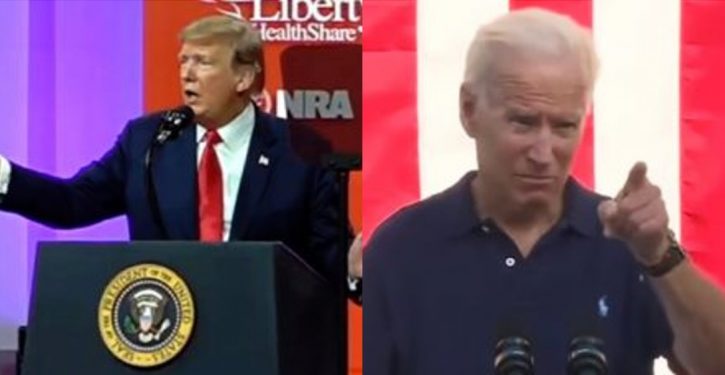
Earlier this week, a depressing economic prognosis linked on the Drudge Report concluded: “A whole lot more pain is on the way, and it is going to shake our nation to the core.”
That forecast also describes my election night nightmare: contested presidential race results with neither candidate willing to concede. The discord is triggered by delays and system failures while county and city election officials work tirelessly, processing the largest number of mail-in ballots in U.S. history.
The nightmare spans election week with “reports” alleging vote-by-mail “irregularities” in a handful of swing states too close to call. Then, on Friday, Nov. 6, in dueling press conferences, both President Trump and former Vice President Biden declare victory. Chaos ensues. Armies of lawyers are mobilized along with the National Guard, and then … fortunately, my alarm clock interrupts the bedlam.
Will this presidential election be the most important in American history?
Is my nightmare detached from reality? Or will a late-fall COVID-19 “second wave outbreak” shift the electorate from in-person to mail-in voting on a scale that could wreak havoc on our democratic process?
Trouble is brewing, as reported in a April 25 Politico piece headlined “States rush to prepare for huge surge of mail voting.”
Quoted was Wendy Weiser, the vice president for democracy at the Brennan Center, who warned: “We’re going to see a substantial switch to mail voting whether or not anybody prepares for it. The question is, will the system be prepared to accommodate and process that, or will it be a real mess?”
For starters, the “real mess” begins well before ballots are even processed on Nov. 3, with every state having different mail-in rules and criteria for requesting an absentee ballot. What could possibly go wrong when mail voting is quickly and dramatically expanded amid the first coronavirus/social distancing/emotionally charged presidential election conducted during the worse economic climate since the Great Depression?
Last month, an NPR report headlined “Coronavirus May Reshape Who Votes and How in the 2020 Election” highlighted the problems:
“Some states require that voters have an excuse — such as being out of state or ill — while others have no-excuse absentee voting. States with all mail-in elections automatically send ballots out to registered voters, while others require voters to request such a ballot. Some states pay the return postage; others do not. Some states require mail-in ballots to be received by Election Day, while others only require that they be postmarked by then.”
Giving credence to my nightmare are potential problems in two “must-win” swing states. The aforementioned Politico piece cites Amber McReynolds, CEO of the nonprofit Vote at Home Institute (more on her later), as noting that “Michigan and Pennsylvania, two of the most important 2020 presidential battlegrounds, are also two of the states at greatest risk” and that both “recently enacted no-excuse absentee voting, meaning they have little infrastructure and have only managed low levels of voting by mail in the past, creating more opportunity for error.”
What amount of “error” is “acceptable” in states that Trump barely won in 2016 — Michigan by 0.3 percentage points and Pennsylvania by 0.7 — when forced to quickly ramp up for “no-excuse absentee” voting? Again, what could possibly go wrong in these two states with a combined total of 36 electoral votes, the winner of which is likely to be the next president or re-elected?

That raises another question: How much new mail-in voting is expected in November?
I asked Michael McDonald, a political science professor at the University of Florida who tracks voter participation at the United States Election Project. “A good guess at this point is half, or more, of all ballots cast will be by mail,” he answered. Then McDonald added that “there are some states where we could see substantially fewer ballots cast by mail, so that 50% nationwide is misleading.”
Interestingly, he pointed out that in 2020, even before coronavirus, “we were already looking at close to 30% mail ballots.” That alone would be record-breaking if compared to 2016 when mail-in ballots accounted for 21% of 128,838,342 presidential votes cast. The figure inched up to 23% during the 2018 midterm elections.
Election officials must heed this warning about the tremendous expected increase. “If states don’t prepare now they won’t have enough equipment,” Amber McReynolds told Politico.
Professor McDonald expressed a much dimmer view: “Even if the federal government today allocated $2 billion for running the November election, the pipeline from the federal to state to local governments where the elections are run is already broken. The insufficient $400 million the federal government has allocated is not flowing to the local election officials who must prepare.”
Disheartened, McDonald told me, “There is not enough time between now and the election to purchase the equipment and do the training we need to manage a large number of mail ballots. We are falling into a black hole, and there is no way out at this point.”
Also sending warnings is President Trump — rigorously messaging against the massive, seemingly unstoppable trend toward mail-in voting. On May 1 he tweeted: “Don’t allow RIGGED ELECTIONS!”
His tweet was accompanied by a RealClearPolitics op-ed headlined “28 Million Mail-In Ballots Went Missing in the Last Four Elections.” (That claim was disputed by McReynolds, the Vote at Home Institute CEO, in a subsequent RCP piece headlined “There Were NOT 28 Million ‘Missing’ Mail-In Ballots.”)
Trump, determined to keep actively supporting in-person voting, told White House reporters on April 7 that “mail-in voting is a terrible thing. I think if you vote, you should go, and even the concept of early voting is not the greatest, because a lot of things happen.”
The next day Trump followed up on Twitter, writing: “Absentee Ballots are a great way to vote for the many senior citizens, military, and others who can’t get to the polls on Election Day. These ballots are very different from 100% Mail-In Voting, which is ‘RIPE for FRAUD,’ and shouldn’t be allowed!”
Who knows, that election “F-word” might become the rallying cry used by both candidates — making the contested 2000 election seem quaint by comparison.
Meanwhile, should we expect Trump’s warnings of “fraud” and “rigged elections” to increase over the ensuing months as mail voting grows in popularity and states loosen criteria and restrictions? Moreover, is he building both a legal platform to launch his defense and a safety net if he falls?

During an election of such great consequence, both parties will have their guard up like never before. And never before has a presidential election relied so heavily on the U.S. Postal Service — a near-bankrupt institution pleading for “$75 billion in cash, grants, and loans” and warning that if funding is not received it could close down operations by June.
Voting expert McDonald is also concerned, telling me, “Post office delivery has slowed, and if you vote by mail that gums up the works.”
Finally, I asked if the forthcoming election keeps him up at night.
“It’s very possible that we are going to have a colossal train wreck come November,” he replied. “We are going to see system failures, people unable to vote, and much litigation firing back and forth. We expect lots of fraud claims, primarily from Donald Trump, that will undermine the legitimacy of the election result.”
Sadly, my election night nightmare with both sides claiming victory could mirror that dire economic outlook linked to by Drudge: “A whole lot more pain is on the way, and it is going to shake our nation to the core.”
Cross posted at RealClearPolitics.




